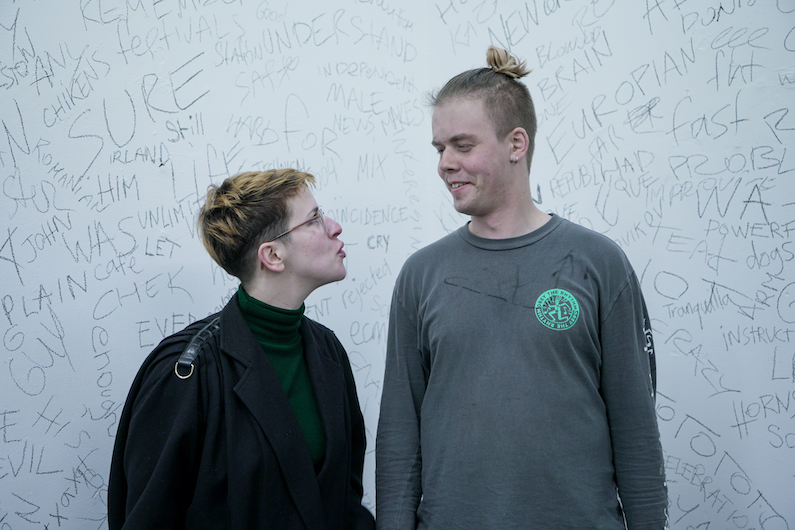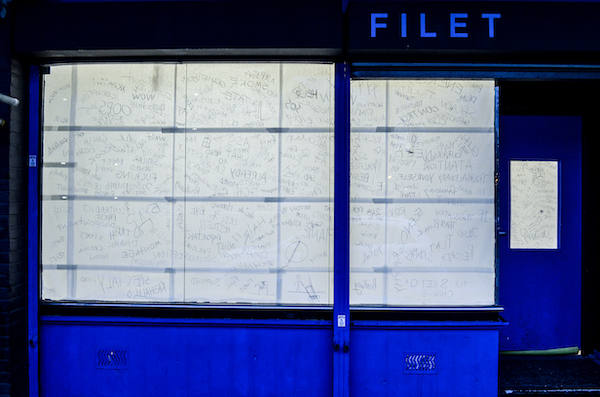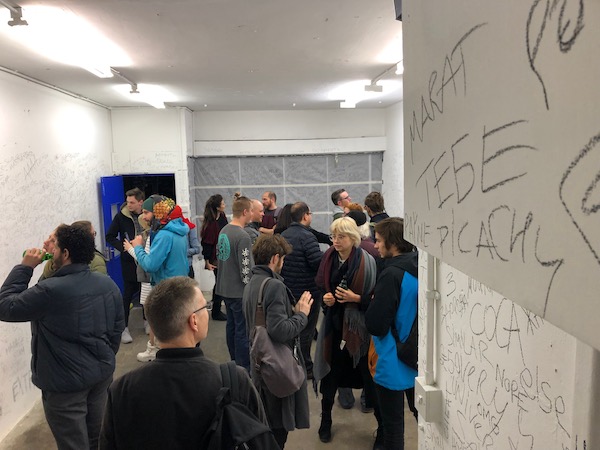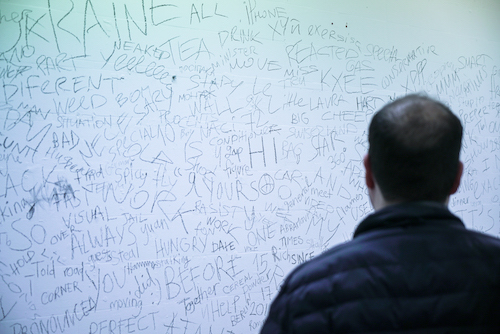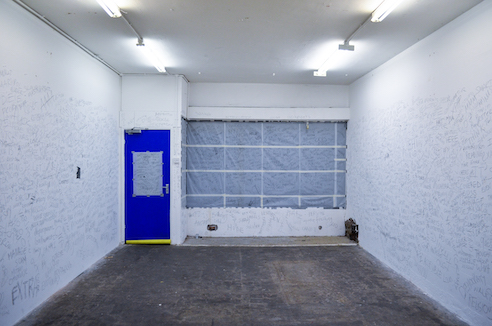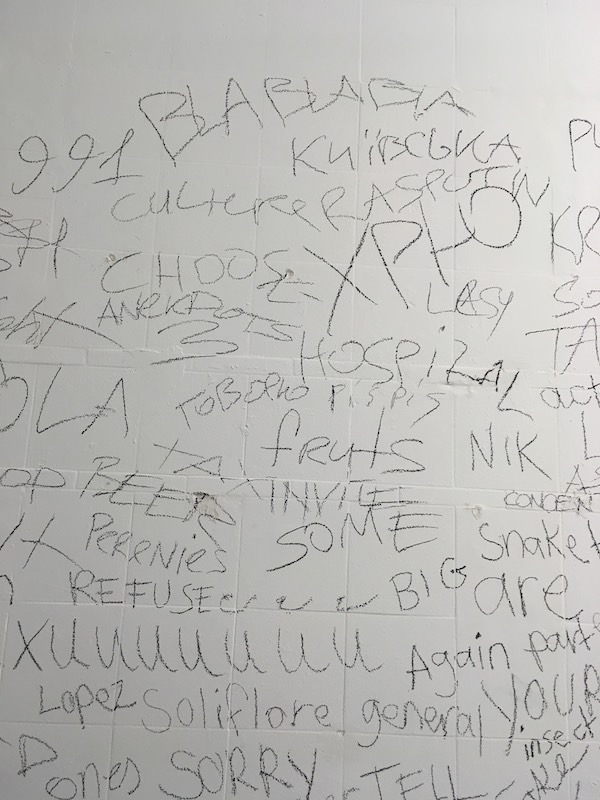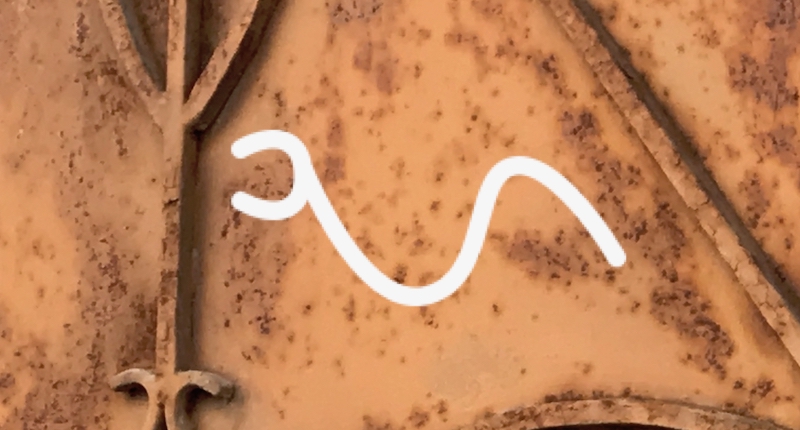Timothy Maxymenko & Iris Colomb at FILET, Hoxton
Reviewed by Calliope Michail, Antony John, Alan Cunningham and montenegrofisher
US2 is a 24 hour performance piece devised by the Ukrainian artist Timothy Maxymenko. It involves two participants with different nationalities, who do not know each other, spending 24 hours in a room together. During those 24 hours, the participants have to keep communicating constantly and must write each new word they use on the gallery walls. At the end of the 24 hours, the space opens to the public and visitors are invited to join the performers and explore the words and other forms of communication which have emerged.
This piece was first performed by four pairs of participants (including Timothy Maxymenko) in four Kraków art spaces simultaneously in 2016. Timothy performed the piece in London with Iris Colomb, from 7pm on 17th March to 7pm on 18th March 2019.
Place two strangers in a room, with the mandate to communicate over the course of 24 hours, limited to as many words as they can write on the walls, and the result is bound to evoke some interesting questions surrounding communication, intimacy and endurance. Walking into the exhibition once it had opened to the public, the buzz of people drowned out the small portable speaker that was replaying a recording of the last 24 hours. What was immediately striking, however, were the charcoal words that filled all four walls, with nouns, verbs, names (like Abramovic), numbers, dates and even small sketches and diagrams (a visual representation of time travel, among others). The main language of communication was English, but the artists’ native tongues, Ukrainian and French, were represented on the walls, as well as scatterings of Spanish, Russian and Chinese. An element of mystery as to what had been discussed between the two artists was present in the fragmented narrative, with only an indexical print in varying sizes and slants (betraying fluctuating moods and energy levels) to hint at what the conversations could have been. Communication is often viewed as a means to an end - content being privileged over the act. This performance highlighted communication as an end in itself - the vivacity, energy, variation and sustainability of interacting linguistically with a fellow human with no known commonalities, in such an intimate space.
- Calliope Michail
In a small room in a parade of shops in Hoxton, Iris Colomb and Timothy Maxymenko completed their 24-hour art work. They spent their time writing in charcoal on whitewashed walls and talking using only the words they had written.
When the work was finished, about 30 guests occupied the space for a couple of hours, chatted and looked at the walls. The following day, the two artists returned to repaint the walls white.
This erasure wasn’t part of the work. It was required by the art space to allow the artists to use it. A quiet, auto-destructive act that removed the physical presence of the work that had been created.
- Antony John
The Sinthome. The term used by Lacan for the excess. After entering the small room at Filet Space and seeing the text covered walls, after talking to one of the two writers/artists who’d been ensconced there for the previous 24 hours, their ability to talk exhausted by a day and nights worth of effort and disengagement with more orchestrated time, I can think only of the idea of the sinthome.
This symptom covers the walls and the wrìters therefore cannot speak I think; one of them, at least, tries to speak to me and some words emerge but she cannot speak, she stumbles in speech, she has exhausted her supply of meaningful words. I feel moved to hug her in recognition, in support of her inability to now speak. This is good, I think, not because I don't want to hear her speak, not because I think she will speak ill but because I think it is also just good.
The inscriptions on the wall then become less words than ways of changing the property of the white washed space itself and my presence there as well, maybe the presence of the others there too, but who am I to tell. Scarification by letter and then word over word enacts less a meaning than a new topology, a new topological reality, a cross cap cut with text from the old mere white space, evidence of enjoyment, presence, being and the subjects who have been there, the length - the time - that they have been there just as well.
It is all evidence now of their utter exhaustion, in line with their inability to proper speak, and thus evidence of their/there having been, their/there being there at one time before and sometime soon (much later, we can only hope) their/there coming into being not at all, at least, we can only hope again, in present type of form.
In other words, all very satisfyingly too much.
- Alan Cunningham
US2 showed how writing is capable of breaking physical space. The work was intense and exhaustive, impossible to view as a whole. Fragmented areas of text opened a way into the maker's relationship. This experience of time through language was dense and unrelenting, our lives are so full of words, meaning is often ambiguous to interpret. The Artists' conversation becomes graffiti, lists codified by the absence of sentences. There is a reference to drawing in the chosen medium of charcoal, and perhaps the Installation becomes that, a 24-hour drawing, traces of two bodies consenting to share a common space and create a shared language of their interaction. Sometimes from the randomness an expression appears, 'insane sleep guess confused hurts jealous cool fuck AAAA'. The constraints of the process impose a control not too disimilar to confinment in a cell, the walls become metaphors of imprisonment, the words attack this control, they become weapons of freedom.
- montenegrofisher
Reviews published 12 April 2019 - London, United Kingdom

